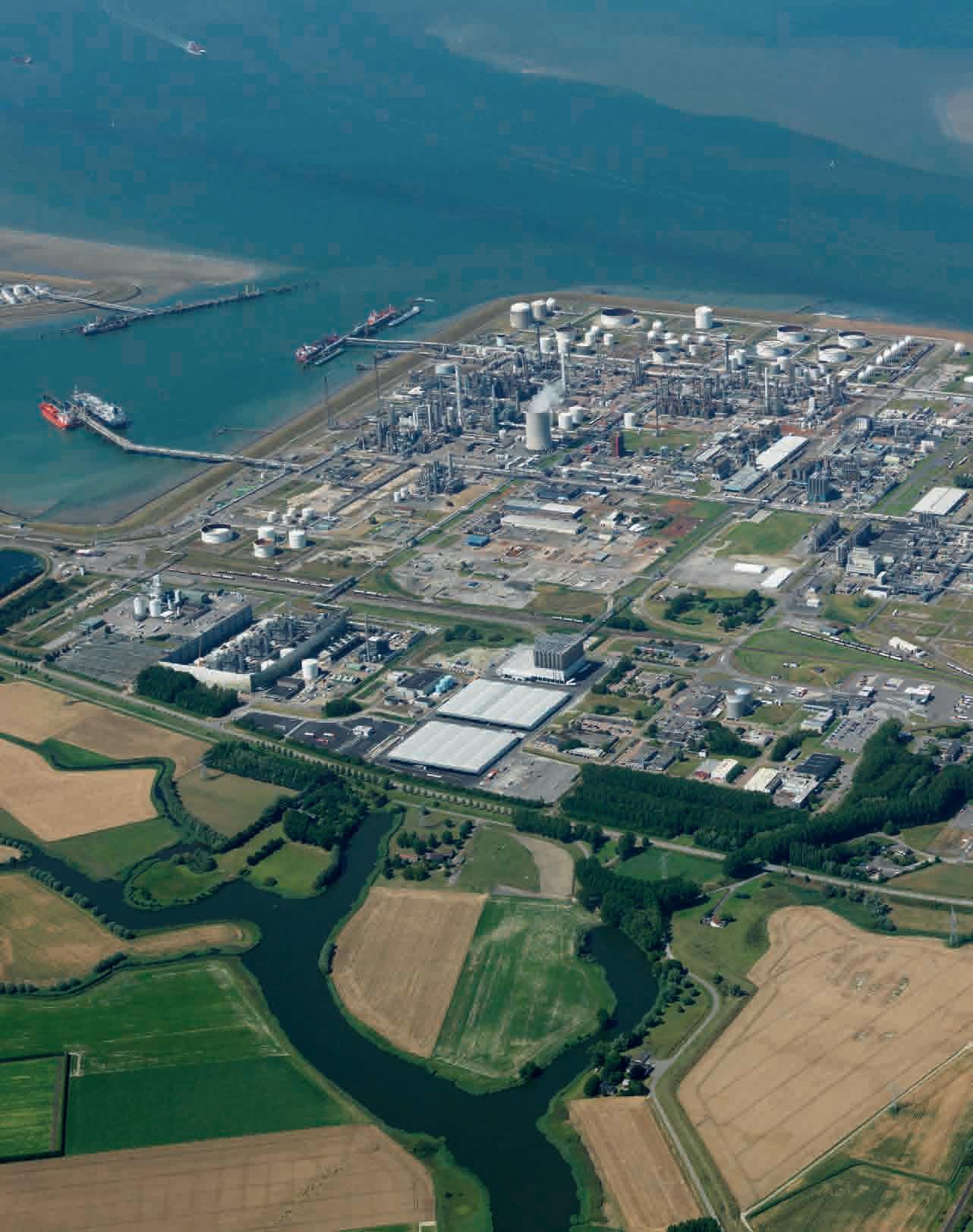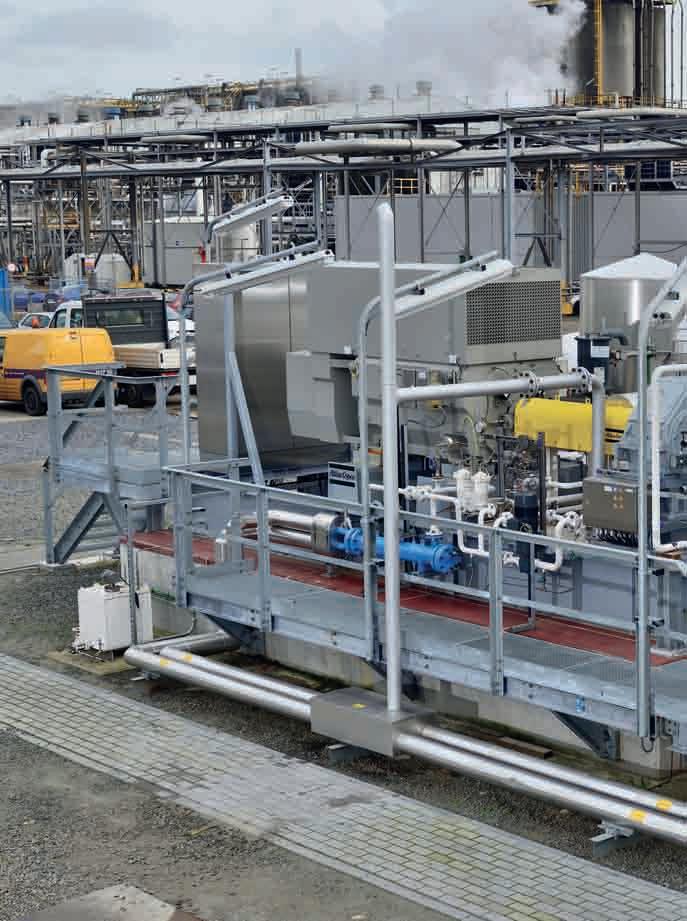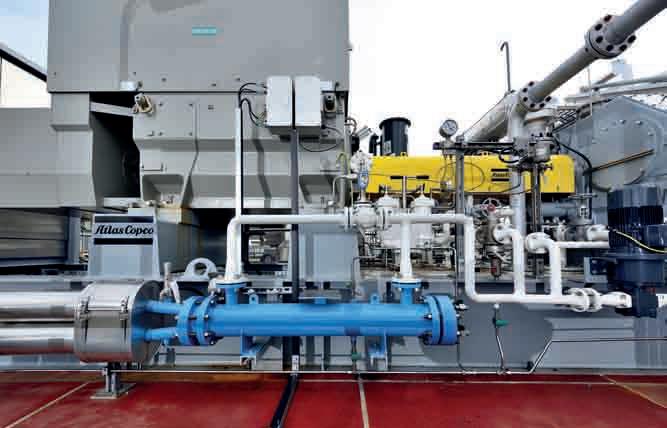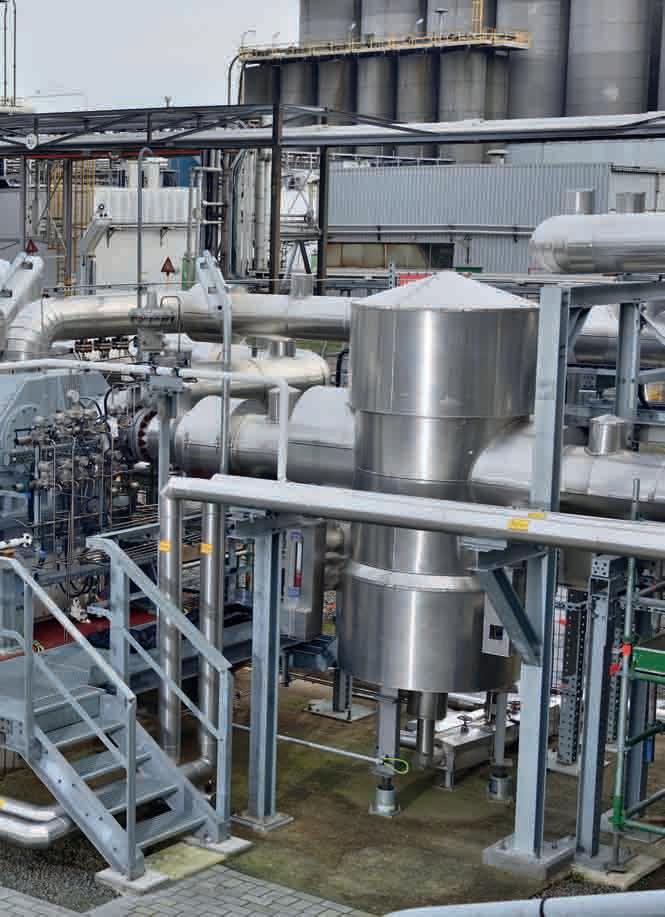
9 minute read
Breakthrough in steam recycling
Recompression technology delivers
A small-scale pilot project with steam recompression at the Dow site in Terneuzen has proven that reusing steam in industrial processes is not only technically feasible, but is indeed a great way to reduce CO 2 exhaust gases.
After a nine month trial period, the numbers are in. The machine that was built to recompress residual steam at the site, more than delivers; it annually reduces Dow’s CO 2 exhaust emissions by 20,000 tonnes. What is even better is the fact that this technology can potentially achieve tenfold that amount; the machine built for this pilot project only compresses 1% of Dow’s residual steam, so the company is now investigating how to further develop and upscale the system. “In hindsight, successful innovations always seem simple,” says Kees Biesheuvel, Technology Innovation Manager at Dow, with a smile. “But this technological breakthrough was a long time coming. I had been researching and preparing this project for approximately four years before construction on the recompression machine had even commenced.”
Reduce or reuse For many companies in the chemical, agro-food, paper, and horticultural industries, heat is the largest energy consumer. In order to achieve the climate targets for 2050, figuring out how to either reduce residual heat or reuse it is an essential question. This also goes for Dow’s chemical processing plant in Terneuzen. The company has a lot of residual heat, which has a temperature of around 130-140°C. For Dow to be able to reuse it, the steam needs to be heated to 240°C. The problem was that no one in the world had managed to achieve such a massive temperature increase in steam through recompression – ever. The idea to develop a steam recompressor came to life through the Institute for Sustainable Process Technology (ISPT), a collaborative partnership between about a hundred processing businesses, universities, and knowledge institutions in the Netherlands. At ISPT, Mr Biesheuvel is the director of the industrial heat cluster. In this inspiring environment, Mr Biesheuvel researched the technological possibilities to upgrade steam. He found out that the food and salt industries were already using steam recompression machines that achieved a small temperature increase in steam in a highly energy-efficient way. “It was great to see that the fundamental, physical principal was already in use,” says Mr Biesheuvel, “but the temperature differences that need to be bridged in those industries are minor. Nobody had figured out how to bridge the temperature gap that I had in mind, which was around 100°C.”
Increasing the pressure The amount of energy required to make heat move from A to B depends on the phase transition. When you condense steam, an enormous amount of energy is released – the same amount that you needed to create that steam out of water. When steam cools off too much or its pressure becomes too low, its energy cannot be retrieved. Mr Biesheuvel and his team thus needed to figure out how to increase the steam’s pressure, so that it condensates at a higher temperature and releases that large amount of energy at a higher temperature. To do so, they needed a machine that increases pressure; a recompressor. Mr Biesheuvel continues, “Studies in the field of steam recompression have been done for decades, I found some dating as far back as the 1980s.

Photo courtesy of ISPT
KEES BIESHEUVEL, TECHNOLOGY INNOVATION MANAGER AT DOW.
Several suppliers that I spoke with found references in their old paper archives that proved their companies had contemplated venturing into this direction, but it was never opportune.” It is a different world today than it was a few decades ago. Building machinery has become significantly cheaper, and there is a far greater and cheaper supply of green electricity. Moreover, there is momentum. Never has there been a stronger demand for sustainability and corporate environmental friendliness.
Green light Once Mr Biesheuvel and his team figured out the best technological approach to steam recompression, they turned the theory into a reality. They convinced everyone involved of their idea, its technological and economical feasibility. The project was discussed with the government and a funding framework for sustainable energy innovation was drawn up. The provincial government of Zeeland also became involved through the Green Deal programme. Dow also heavily invested in the project; in the construction of the recompressor, but also in engineering, research, and development. When all lights were on green, it took almost another year for the machine to be built, and several more months before it was put in place and connected to Dow’s systems. Then the engineers had to learn how to start it up and fix some teething problems. “It was a learning curve, but that is why you do a pilot project like this – to gain that experience.” The steam recompressor was designed to save up to ten tonnes of steam per hour. After a nine month trial run, the machine actually proved to be saving fourteen tonnes an hour.
Not stopping here Dow has worked out a plan towards achieving its goal of being carbon neutral by 2050. The circular use of heat in chemical processes is one of its pillars. “We use a lot of steam at Dow Terneuzen and it is a waste not to reuse the energy that is captured in this. Now that we have proof that this technology works, it can really help us achieve circular heat use,” says Mr Biesheuvel. He thinks that the positive outcome of the pilot project has guaranteed a place for steam recompression in the next steps towards carbon neutrality. “When Dow needs to build a new factory, they can incorporate a recompressor unit into the design without hesitating, knowing it will work.” Apart from the long-term planning up to 2050, Mr Biesheuvel and his team are also looking into whether they can speed up the implementation of this technology in Dow’s processes. The current steam recompression machine on site accomplishes a 0.5% reduction of Dow’s CO 2 emissions. How big that percentage can become by upscaling is hard to predict. “It depends on the entire configuration modifications. A steam
Photo courtesy of Dow Chemical

Photo courtesy of Dow Chemical

THE STEAM RECOMPRESSION MACHINE THAT WAS BUILT FOR THE PILOT PROJECT AT DOW TERNEUZEN.
system on an integrated site like Dow’s in Terneuzen behaves like an electricity grid,” he explains, meaning that a new and larger steam recompressor can only be installed to replace another (fossil) energy source. They need to match precisely. “You cannot preserve steam. So you need to find a balance between supply and demand.” To increase the steam’s pressure from 3.5 bar to 12 bar, and
IT TOOK ALMOST A YEAR FOR THE MACHINE TO BE BUILT, AND SEVERAL MORE MONTHS BEFORE IT WAS PUT IN PLACE AND CONNECTED TO DOW’S SYSTEMS.


To be able to reuse Dow’s steam, it needed to be heated to 240°C. The problem was that no one in the world had managed to achieve such a massive temperature increase in steam through recompression – ever.
thereby make the entire energy content of the steam available, you only need a small amount of energy – maybe as little as one tenth of the energy released. “This incredible energy efficiency makes this technology one of the first options you would consider, financially too,” continues Mr Biesheuvel. “But like I said before, the essential question is not about economics but about the supply and demand situation on site.” Over time, Mr Biesheuvel thinks Dow could increase its steam recompression capacity to upscale the current 0.5% CO 2 reduction to 10% – totaling 400,000t annually. “400,000 tonnes; that is a spectacular prospect.”
Promising technologies Steam recompression is merely one technology that Dow is looking into in its quest to achieve carbon neutrality. When asked what technologies he finds most promising for the future, Mr Biesheuvel has a clear answer: electrification in general. Fully adapting the chemical processes at Dow to electrification is, however, easier said than done. “Adaptation is an understatement. Most of the time, we actually need to reinvent the entire process.”
Hydrogen Mr Biesheuvel also considers the prospects that hydrogen offers. During Dow’s chemical processes, a lot of hydrogen is released. Part of the hydrogen is transported to Yara Sluiskil, who use it in their processes. Dow is also cooperating with ArcelorMittal to research a chemical process involving hydrogen. The idea is to add CO from ArcelorMittal to hydrogen to create naphtha, an important base material for many of Dow’s products. “I believe hydrogen’s best application is as a chemical building block,” says Mr Biesheuvel. “There is a lot of buzz about using hydrogen to heat our houses or fuel our cars. But you achieve a much larger CO 2 reduction if you use it in a chemical application.”
Plastic recycling What happens in the market is decisive. If demand for a certain product falls, you cease producing it – no matter how good it is. “Take the position of plastic, for example,” explains Mr Biesheuvel. “People are trying to reduce their use of plastic and search for alternatives. Then suddenly, a different factor comes into play and changes the game.” Mr Biesheuvel refers to the current coronavirus crisis to make his point. “Due to Covid-19, the demand for plastics is surging. To prevent contamination, food and medical products need extra packaging, and large amounts of plastics are needed for protective suits and masks. Our society cannot function without plastics. Not with this many people living so closely together.” Therefore, according to Mr Biesheuvel, another key technological innovation area is in plastic recycling. More specifically: chemical recycling, which gives plastics back their primary function by breaking it down on a molecular level and rebuilding it, instead of downcycling it into lowgrade materials. “You can learn a lot by looking at nature. When a leaf falls from an oak tree in Autumn, it will not return as an oak leaf next year. Everything in nature is chemically recycled in the circle of life.” Mr Biesheuvel believes that the key question is how to get the material flows that become available post-function back to the processing location.
the energy transition. Dow is sharing its knowledge on steam recompression with other businesses, which means that this prototype could set a revolution in steam recompression in motion throughout similar industries. While the pilot project was still being implemented, its technology already became included in the SDE ++ funding, a government funding scheme for sustainable energy production as of 2020. Moreover, it has been listed in European regulations as one of the most promising technologies.










